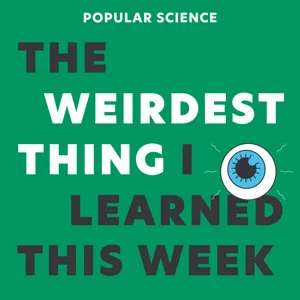Podcast Summary
Exploring the Benefits and Challenges of Technology: Angie's platform connects users with pros for home projects, Bayer uses AI and CRISPR for food production, consider ethical implications, Bethany's book examines our relationship with animals and the consequences of labeling species as pests.
Technology is revolutionizing various industries, making things easier for individuals and businesses. Angie's platform simplifies home projects by connecting users with skilled professionals, while Bayer uses AI and CRISPR technology to increase food production. At the same time, it's essential to consider the ethical implications of these advancements. Bethany's book, "Pests: How Humans Create Animal Villains," explores our complex relationship with animals and the consequences of labeling certain species as pests. These stories remind us of the potential benefits and challenges of technology and the importance of thoughtful innovation.
Myths and Surprising Facts about Animals and Medical Beliefs: While some animal behaviors and historical medical beliefs may seem surprising or even incorrect, it's crucial to fact-check and question their origins.
Our understanding of animals and their behaviors, as well as historical medical beliefs, can be filled with surprising and sometimes incorrect information. During the discussion, we learned about the aye-aye lemur and its unique ability to use its long fingers to dig in its nose and eat snot. While finding this behavior adorable, the speaker also shared her fascination with Australia and its unique wildlife, leading to her tease about scientists using poisoned toad butts to save predators. The main topic, however, revolved around the common factoid that when trains were first invented, men believed women's uteruses would fly out due to the speed. After extensive research, the speaker admitted that she couldn't find concrete evidence to support this claim, emphasizing the importance of fact-checking and questioning the origins of widely-spread information.
The early days of the Internet and fact-checking: Be skeptical of information, especially if it seems too sensational or too good to be true. Verify facts and check sources to ensure accuracy.
The reliability of information, especially during the early days of the Internet, was not as trustworthy as it is today. The speaker recalls a time when fact-checking was not common practice, and information from books or older Internet sources were often considered more trustworthy than modern sources. However, this assumption is not always accurate, as misinformation and myths can be perpetuated through various means, even from seemingly credible sources. The speaker shares an example of the myth about Victorian women's uteruses flying out of their bodies due to train travel, which originated from an offhand comment in a 2011 interview. The speaker emphasizes the importance of critical thinking and fact-checking, and encourages listeners to be skeptical of information, especially if it seems too sensational or too good to be true. In essence, the Internet's wild west era has passed, but the responsibility to verify information remains.
Fear and Moral Panics in the Victorian Era: Railway Travel: Historically, new technologies or discoveries have sparked moral panics and fear-based reactions, fueled by media coverage and sensational stories. These fears often subside as people become more accustomed to the new technology or trend.
Throughout history, there have been instances of moral panics and fear-based reactions to new technologies or discoveries. The discussion focused on the Victorian era and the fear surrounding railway travel, with concerns ranging from physical discomfort to mental instability and even the possibility of being surrounded by dangerous individuals. The fear was fueled by media coverage and sensational stories, leading to a moral panic that persisted despite medical reassurances. Similarly, in modern times, there have been instances of moral panics surrounding new technologies or trends, such as social media, which can lead to an overreaction based on rumors and fear rather than facts. It's important to remember that these fears are often rooted in the unknown and the unfamiliar, and as time passes and people become more accustomed to the new technology or trend, the fear subsides.
Historical fear and moral panic over new technologies: Throughout history, new technologies have sparked fear and moral panic due to their perceived dangers and unknown consequences, but most have ultimately brought about significant advancements and improvements to society.
Throughout history, new technologies and innovations have often sparked fear and moral panic due to their perceived dangers and unknown consequences. The railroad industry in the 1800s is a prime example, with concerns over traumatic injuries from high-speed collisions leading to the belief in a new illness called "railway spine." People's fascination with train wrecks during this time further fueled the fear. This phenomenon is not unique to the railroad industry, as ancient Greek philosophers, Romans, and other societies have expressed similar concerns over writing, telephones, zippers, and even novels. Despite these fears, most of these technologies ultimately brought about significant advancements and improvements to society.
The cycle of technology panics about young people: Perception of technology as a tool vs unstoppable force, impact on adolescents as a new social construct, flawed studies on technology's impact, and the importance of an open and informed perspective
Moral panics about new technologies and their impact on young people are not a new phenomenon. From the 1800s with books like Wuthering Heights, to the early 1900s with radio, and up to present-day concerns over social media and gender affirming healthcare, adolescents have often been at the center of these debates. Amy Orban, an experimental psychologist from Cambridge University, refers to this cycle as the "Sisyphean cycle of technology panics." Orban argues that what has changed is our perception of technology. Instead of viewing it as a tool that we control, we now see it as an unstoppable force that requires reckoning. This shift is significant because adolescents, as a relatively new social construct, have more free time and a greater ability to adopt new technologies than previous generations. Furthermore, Orban emphasizes that studies on technology's impact on youth are often flawed, making broad assumptions about usage and neglecting the nuances of individual experiences. Despite these concerns, it's essential to remember that technology is constantly evolving, and it's crucial to approach it with an open and informed perspective.
Exploring New Technology and the Natural World: Appreciate new technology's benefits while considering risks, and remember the natural world's beauty and diversity. Use technology to simplify life and find joy in unexpected creatures.
New technology, like the use of artificial intelligence and CRISPR technology in agriculture by Bayer, can bring about significant benefits, but it's important to consider potential risks and innovate to keep things safe and effective. Meanwhile, in the natural world, unusual creatures like the aye-aye of Madagascar, with their peculiar appearance, serve as reminders of the beauty and diversity of the natural world. It's essential to appreciate new things while also being mindful of potential dangers and remembering that old things are not always safe. The use of technology, such as Angie's app for home projects, can simplify our lives and help us get things done efficiently. And sometimes, the most unexpected creatures, like the aye-aye, can bring joy and wonder.
Discovering the Unique Features of the Aye-Aye Lemur: The Aye-Aye lemur is a nocturnal primate with unique features including bat-like ears for echolocation, continuously growing incisors, specialized long fingers, and an extra tiny thumb on each wrist.
The Aye-Aye lemur, despite its initial terrifying appearance, is a fascinating and wonderful nocturnal primate with unique features such as bat-like ears for echolocation, continuously growing incisors, and specialized long fingers. Researchers have discovered that they have an extra tiny thumb on each wrist, which might have evolved to help them climb and grip things. Their longest finger, accounting for more than two-thirds of their hand length, is used for tapping on bark and wood to find insects and can also be used to drink water and eat fruits. A recent study revealed that they use their long middle finger to pick their nose, much like humans. Despite their size and appearance, the Aye-Aye lemur is a remarkable creature that continues to intrigue scientists and animal lovers alike.
Aye-aye lemurs practice mucophagy, or nose-cleaning and eating mucus: Aye-aye lemurs regularly engage in mucophagy, a behavior where they clean their noses and eat the mucus for potential health benefits, but the reasons behind this behavior are still unclear
A study published in the Journal of Zoology revealed that aye-aye lemurs insert their fingers into their noses, clean them, and eat the mucus, a behavior called mucophagy. This behavior is not a one-time occurrence but a habit for them. Researchers used CT scans of museum specimens to understand the depth of the finger's reach, which is likely all the way down to the throat. The reason behind this behavior, however, remains unclear, with theories suggesting it could boost the immune system or improve oral health. Mucophagy is also observed in a few other primate species, including humans. Despite the potential health benefits, there are also contradictory studies that suggest picking your nose and eating boogers could introduce harmful bacteria. Overall, the study highlights the interesting and shared behaviors between primates.
The Aye-Aye lemur and Cane Toads: Unconventional Pest Control: Despite their unusual appearances and negative folklore, the Aye-Aye lemur and cane toads can contribute to pest control. However, understanding their unique behaviors and conducting thorough research is crucial to prevent unintended consequences.
The Aye-Aye lemur, despite its frightening appearance and negative folklore, can be beneficial as they consume insects that infest sugarcane crops. However, their numbers are endangered due to habitat loss and negative perceptions. Meanwhile, in Australia's past, an attempt at biocontrol using cane toads to eradicate cane grubs proved disastrous as the toads did not dig and could not effectively reach the grubs. This historical blunder led to the widespread proliferation of cane toads, causing more harm than good. Overall, both the Aye-Aye and cane toads serve as examples of the importance of proper research and understanding before implementing solutions. The Weirdest Thing celebrates such oddities and encourages appreciation and wonder towards them.
The introduction of cane toads in Australia led to the decimation of various species: The poisonous shoulder pads of cane toads led to the death of native predators, causing the decimation of crocodiles, snakes, and monitor lizards. Despite efforts to control their population, cane toads continue to adapt and spread throughout Australia, causing ongoing problems due to their invasive nature and unpopular appearance.
The introduction of cane toads in Australia led to a complex invasive species issue due to their poisonous shoulder pads that proved deadly to native predators. This resulted in the decimation of various species such as crocodiles, snakes, and monitor lizards. Despite efforts to control their population, cane toads have continued to adapt and spread throughout Australia, causing ongoing problems due to their unpopular appearance and invasive nature. They have even developed cannibalistic behaviors and are able to hop further during the invading edge of their wave. This documentary, "Cane Toads and a Natural History," is a must-watch to learn more about this fascinating and persistent invasive species.
Helping predators adapt to cane toads: Scientists use non-poisonous alternatives and breeding less poisonous toads to reduce predator deaths caused by invasive cane toads
Scientists in Australia are using various methods to help predators adapt to the invasive cane toads, rather than trying to eradicate them completely. These methods include feeding predators non-poisonous alternatives that taste and smell like toads but contain a harmless chemical to deter them from eating poisonous toads. For example, toad-flavored sausages laced with lithium chloride are given to some predators, while freshwater crocodiles are given the back halves of toads stuffed with the chemical. Additionally, breeding and releasing less poisonous baby cane toads into the wild has been effective in reducing predator deaths. These methods have significantly reduced the number of predator deaths in areas with cane toads, making it a more effective solution than none at all. Despite the odd image of a lab being part kitchen and part toad butcher shop in the Australian outback, these methods have proven to be crucial in helping predators survive the arrival of cane toads.
Facts about animal vomiting and eradicating animal pests: Some animals can vomit, while others cannot. Scientists have gone to great lengths to eradicate invasive animal pests like cane toads in Australia, as discussed in the book 'Pests, How Humans Create Animal Villains'.
Not all animals are capable of vomiting. While humans and some animals like elephants can, others like rodents and crocodiles cannot. During the conversation, the hosts also shared fascinating stories about cane toads and the lengths scientists have gone to in attempts to eradicate them in Australia. The book "Pests, How Humans Create Animal Villains" delves into these topics and many more. If you're intrigued, mark your calendars for December 6th when the book will be available for purchase. The hosts also reminded listeners that the show is available on all major podcast platforms and encouraged them to rate and review it to help others discover it. Additionally, they mentioned Angie, a service that simplifies the process of finding skilled professionals for home projects, and Paint Care, a program dedicated to reducing paint waste.






